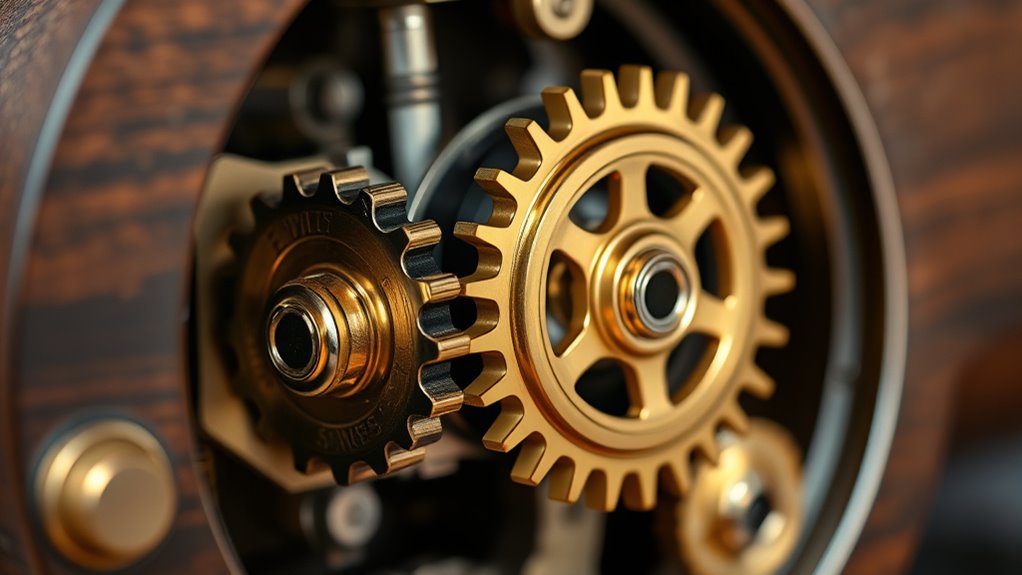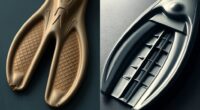The tilt mechanism was invented to improve furniture comfort and support by allowing you to adjust your chair’s angle easily. It lets you lean back, shift weight, and find a natural, relaxed posture, which helps reduce strain on your spine, neck, and shoulders. This innovation transformed static seating into something more dynamic and ergonomic. To discover the full impact of this invention and how it shaped modern furniture design, continue exploring further.
Key Takeaways
- The tilt mechanism revolutionized furniture by enabling adjustable reclining for improved user comfort and ergonomic support.
- It was developed to allow users to lean back, shift weight, and modify posture easily during sitting.
- The invention aimed to reduce strain on the spine, neck, and shoulders by promoting dynamic movement.
- It evolved from static chairs to include locking and free-tilt functions, enhancing flexibility and user customization.
- The tilt mechanism significantly advanced ergonomic furniture design, promoting active sitting and better long-term health.

The invention of the tilt mechanism revolutionized how chairs and other adjustable furniture accommodate user comfort. Before its development, seating options were often static, forcing users to adapt to rigid designs that ignored natural body movements. With the tilt mechanism, you can now lean back, shift your weight, and adjust your posture easily, making sitting more comfortable and less tiring. This innovation directly improves ergonomic benefits by allowing your body to move freely, reducing strain on your spine, neck, and shoulders. It’s a simple device, but it has a profound impact on comfort, especially during long periods of sitting, whether at work, home, or in other environments. Additionally, the widespread adoption of adjustable tilt mechanisms has contributed to better overall ergonomic design in furniture.
The tilt mechanism enhances comfort by enabling natural movement and reducing strain during long periods of sitting.
The design evolution of the tilt mechanism reflects a continuous effort to improve user experience. Early chairs lacked any form of adjustability, forcing users into awkward positions. Over time, designers recognized the importance of allowing movement and flexibility, leading to the creation of mechanisms that could tilt, lock, or free-float. As these features evolved, so did the understanding of ergonomic needs, emphasizing the importance of dynamic support rather than static furniture that might contribute to discomfort or musculoskeletal issues. Today’s tilt mechanisms are often integrated with other adjustable features, like height and lumbar support, forming a holistic ergonomic solution. This progression showcases how thoughtful design changes have prioritized user well-being and productivity.
You benefit from the tilt mechanism because it encourages active sitting, which helps you maintain better posture and reduces the risk of long-term health problems. When you lean back or shift position, you engage different muscle groups and relieve pressure points, fostering a healthier sitting experience. Modern tilt mechanisms are also designed for ease of use, allowing you to lock the chair in preferred positions or enable free tilting for natural movement. This adaptability means you can customize your seat to match your body’s needs, whether you’re working at a desk or relaxing in a lounge chair. The ongoing design evolution continues to optimize these features, aiming to provide maximum ergonomic benefits while maintaining durability and simplicity.
In essence, the tilt mechanism’s invention was a turning point in furniture design. It transformed static seating into an active, supportive experience that aligns with the natural movements of your body. As design continues to evolve, this feature remains a cornerstone of ergonomic furniture, helping you stay comfortable and healthy throughout your day.
Frequently Asked Questions
Who Were the Key Inventors Behind the Tilt Mechanism?
You should know that the key inventors behind the tilt mechanism include prominent figures like Charles and Ray Eames, who contributed to ergonomic design innovations. Their work led to patents that improved chair functionality, allowing for adjustable tilt. These inventors focused on creating a more comfortable and adaptable seating experience, shaping the patent history of tilt mechanisms. Their contributions revolutionized ergonomic design, making chairs more functional and user-friendly.
How Has the Tilt Mechanism Evolved Over Time?
Over time, you’ve seen tilt mechanisms evolve with improved pivot points for smoother movement and more precise control. Adjustment methods have become more user-friendly, shifting from manual levers to ergonomic knobs and digital controls. These advancements allow you to customize your chair’s tilt more easily, enhancing comfort and support during long hours of use. The evolution focuses on making adjustments seamless, ensuring your seating experience stays comfortable and ergonomic.
What Materials Are Commonly Used in Tilt Mechanism Manufacturing?
Did you know that steel accounts for over 60% of materials used in tilt mechanisms? You’ll find durable materials like steel, aluminum, and high-strength plastics in manufacturing, offering excellent material durability. These materials enhance ergonomics benefits by providing smooth, reliable adjustments, ensuring longevity, and reducing wear and tear. Choosing the right materials helps create comfortable, long-lasting chairs that support your posture and daily work needs effectively.
Are There Different Types of Tilt Mechanisms?
Yes, there are different types of tilt mechanisms you can choose from, each offering unique ergonomic benefits and design variations. For example, some allow you to lock the tilt in place, providing stability, while others enable free tilting for better comfort. These options help you customize your workspace, reducing strain and improving posture. By understanding your needs, you can select the mechanism that best supports your ergonomic goals and preferred design.
How Does the Tilt Mechanism Improve User Comfort?
Imagine sitting all day without a tilt mechanism—your neck and back would scream in agony! By using an adjustable tilt, you release incredible ergonomic benefits, allowing you to customize your chair’s position for perfect comfort. This not only reduces strain but boosts focus and productivity. You’ll feel a wave of relief as your chair adapts to your movements, making every workday more comfortable and less painful.
Conclusion
Now that you understand the invention of the tilt mechanism, imagine it as the heartbeat of comfort and control in your daily life. This tiny yet powerful device turns your chair into a dance partner, adjusting effortlessly to your every move. Without it, your workspace would be a rigid, unyielding cage. So next time you lean back, remember — it’s this clever invention that lets you find balance and freedom in every moment.









